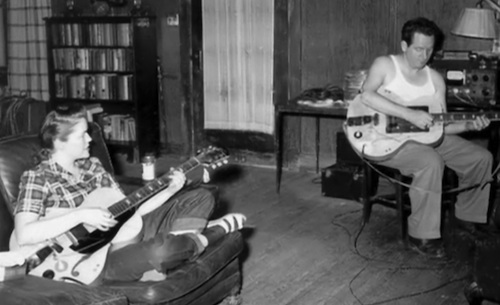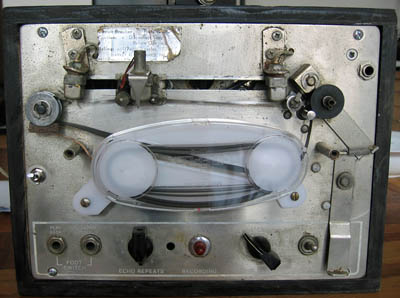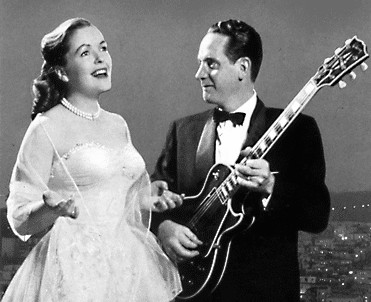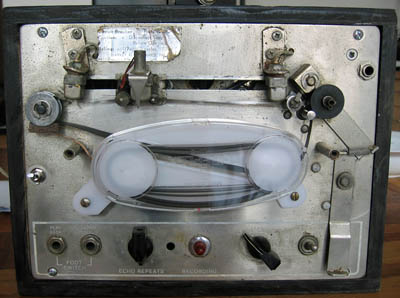In this, the concluding part of our series on the genius Les Paul, we are going to be looking at his contribution to the world of effects. For a modern guitarist, effects pedals are an integral part of their sound. There are a dizzying array of boxes available to feed the contemporary guitar slinger’s G.A.S. (“Gear Aquisition Syndrome”), but in Les Paul’s day an amplifier was a pretty far out concept, let alone tone-bending stomp boxes! As usual Les broke out his tool kit and did some inventing…

We’re going to see how Les moved from capturing sounds to creating new ones, with Delay Effects, Vari-Speed, Special Vocal Effects – and a distinctive playing style to boot.
Les Paul’s Delay Effects
The effects most commonly associated with Les Paul are ‘delay’ or ‘echo’ effects. Many Les Paul recordings feature some kind of echo on the main guitar.
In the previous part we talked about Les’ involvement in the development of tape recording. Tape recorders have:
- a record head, which copies the sound onto the tape, and
- a play head which plays the sound back again
Les realised that if you position the play head after the record head and feed the signal coming from the play head back into the record head it creates a repeat or echo on the tape.
At first it might be confusing to understand why this works, but it’s much easier to get your head around it if you consider an example:
(For more on tape delay, see Hearing Effects: Echo… (echo… echo…))
The most common type of delay you will hear on Les’ records is a short delay often referred to as a “slapback”. This slapback delay has become synonymous with the rockabilly guitar sound.
Soon guitarists wanted to produce these amazing sounds when playing live, and with devices like the Echoplex (which put a loop of tape and play and record heads in a convenient box) the door was opened for all manner of sonic experimentation.

An EchoPlex Delay Effect Machine (Image: pheezy@Flickr)
Guitarists like Brian May of Queen took this to its logical conclusion using delays to allow him to play harmonies with himself, demonstrated here in one of his classic “Brighton Rock” solos (from 2:15 on):
Brian May using delay effects in his solo (2:15 on)
In modern music, The Edge of U2 is considered the master of using delay effects to produce rhythmic soundscapes. Our old pal Lester got there first though! Just listen to the cascading tape delay rhythms in this track:
The Les Paulverizer
When talking about Les Paul and effects, the famous “Les Paulveriser” will eventually be mentioned. Unfortunately this effect never existed!In the 1950s the idea of multi-track recording was still pretty revolutionary and Les learned that people found it pretty baffling that he appeared to be a one man guitar army.
To avoid having to explain the technology to the audience of his concerts and TV shows, he came up with the idea of a fictional box he had invented called the “Les Paulveriser”, which multiplied sounds. When performing live, the device identified as the Les Paulveriser was in fact the start button for the backstage tape machines which played his backing tracks!
Vari-Speed
Delay wasn’t the only tape-based innovation pioneered by our old mate Lester: we also have him to thank for Vari-Speed effects.
Those of us old enough to remember cassette tapes (feeling old yet, 30-somethings?) will recall tracks suddenly descending into rumbling Barry While tones as the Walkman ran out of batteries, or the cassette deck chewed up your precious copy of Rio. Back in the early days of tape, getting machines to run consistently at the same speed was a real challenge and often ended up with songs being transferred to disc at the wrong speed. An interesting aside for blues geeks is that on really old recordings like those of man/myth Robert Johnson there was no fixed speed for recording so no one really knows what they should actually sound like – just a guess at the right speed! Slowing down a tape on playback lowers the pitch and the speed of the music, whereas doing the same thing while recording has the opposite effect.
Ever one to turn a quirk of technology to his advantage Les realised that by messing about with the speed of the recording machine he could create all sorts of previously-impossible sounds.
Even back in the 40s every guitarist wanted to be the fastest and Les found that by playing with the tape running at half speed his riffs would end up twice as fast and an octave up in pitch. Les used this technique from his earliest days of multi-tracking and you can hear this characteristic on his first hit single “Lover” and its B-side “Brazil”.
Les Paul playing Lover, live in the studio
If you listen to the tracks you’ll hear that it isn’t just the speed and pitch that has changed: the timbre (or character) of the notes has also been affected. Doubling the speed of the note has increased the attack speed and doubled the frequency of the harmonics. To my ears this gives it more of the character of a smaller-bodied instrument, like a mandolin. Les was always honest about the double-speed effect, but once it was introduced there were always persistent rumours about any hot new guitarist on the block receiving an unfair speed advantage from the hand of the producer!
Aside from the music of Les Paul you won’t hear the double-speed guitar effect used all that much. Notable exceptions are the intro to KC And The Sunshine Band’s “Get Down Tonight” and the outro to Purple Haze by Jimi Hendrix.
Vari-speed effects really caught on with record producers working with vocalists. Often during the recording of an album it will be discovered that the vocalist can’t cleanly hit some of the high notes. Before vari-speed this might require starting from scratch and recording the song in a new key. With a vari-speed tape machine you could simply slow the track down to record the vocal at a lower pitch and then speed it back up again. Unfortunately for artists that relied on this technique a little too much to flatter their vocal range, it has the same effect on vocals as it does on guitars and can make the voice sound thin and nasal if relied on too much.
The recent emergence of Autotune technology (particularly abused in shows such as X-Factor and Glee) has rendered vari-speed effects obsolete, but the sped-up sound still finds a place in the accelerated samples of hip-hop artists like Kanye West.
Why tape does speed affect pitch?
It’s quite easy to understand why changing the speed of a tape machine should change the speed of what you have recorded, but what might not be so obvious is why this should also change the pitch. We can demonstrate why this is so with a simple thought experiment.The pitch of a sound wave is determined by how close together the peaks of the waves are (referred to as the wavelength). The closer together the waves are, the higher the sound’s pitch.
Imagine a long strip of paper with a pen above it, dangling back and forth from a piece of string. If we swing the pen and steadily pull the strip of paper in another direction, the pen will draw a wavy line on the paper. We can think of this wavy line as our sound wave on the tape. If we pull the paper faster the waves will be more stretched out, so the pitch will drop. If we slow it down, the waves will get closer together and the pitch will get higher.
You can learn more in our Frequency Fundamentals series.
Vocal Effects: Close Mic’ing and Double-Tracking
 It wasn’t just guitar playing where Les pushed forth the frontiers of recording. He also applied his inventor’s brain to vocal sounds.
It wasn’t just guitar playing where Les pushed forth the frontiers of recording. He also applied his inventor’s brain to vocal sounds.
Since the dawn of time, singers who wanted to wanted to be heard by a large audience have had to learn to project their voice. From opera to jazz, singers pushed it out from the diaphragm to reach the back of the room. When it came to recording, people sang as they always did out of habit – but there was really no need! Les and his then-wife Mary Ford developed the idea of “close mic’ed” vocals, where the singer approaches the microphone more closely and can then sing in a more relaxed, quiet way.
Much of Les and Mary’s recording was done at home or in hotel rooms on tour, and it may have been the need to keep the volume levels down that encouraged them to develop this distinctive singing style. The “close mic” vocal technique provides a wonderful intimate quality to a vocal performance. Listen to this superb Mary Ford vocal, for example:
The new technique of working the microphone to control the sound gave rise to the era of the crooner and helped propel the era’s star vocalists to new heights of fame. Listen again to “How High The Moon” above, this time to appreciate Mary Ford’s intimate singing.
It wasn’t just the guitars that were multi-tracked in Les Paul recordings. The vocals were also multiplied. Layering vocals on top of one another allowed Mary to create elaborate harmonies and become a one woman choir. As well as harmonising, Mary’s vocals were thickened by layering the same part multiple times in a process called “double-tracking”.
Les’ technical brilliance is not the only thing to admire here. The incredible precision of Mary Ford’s vocals in creating these dense vocal soundscapes (in an era when getting it right first time was essential) has rarely been surpassed, even to this day.
Listen to her precision in this heavily-layered recording of Tiger Rag:
Double-tracking is loved by record producers, as it makes choruses sound huge – but hated by vocalists, as to do it accurately is time consuming and requires high precision, like that of Mary Ford. The approach of some vocalists is simply to take a really loose approach instead. For example, Kurt Cobain, who in places doesn’t even sing the same lyrics in both tracks!
Though Mary and Les can lay claim to inventing double-tracking, the process was perfected by engineers working with the Beatles at Abbey Road. John Lennon hated double-tracking vocals and at his request a technique was developed using Les’ favorite effect, tape delay, with a few special tweaks, to automatically add a double-tracked vocal part. This a technique later came to be known as “automatic double-tracking” or ADT.
But What About The Playing?
With all this talk of technology, it’s easy to forget that Les was first and foremost a guitar slinger extraordinaire.
Les started off in a variety of hillbilly acts, but his real musical passion was jazz, and particularly the gypsy jazz of the amazing Django Reinhardt:
Before TV stardom beckoned and his hit-making with Mary Ford took off in earnest, Les was a real hot shot guitar-for-hire, playing with Nat King Cole and Bing Crosby. Listen to the red hot duelling solo from 7:00 onwards in this recording from Jazz At The Philharmonic:
This fusion of hillbilly, gypsy and traditional jazz developed his solo output into a unique sound. Les’ later multi-tracked work is often dismissed for being somewhat novelty (and certainly tracks like “Goofus” do nothing to dispel this myth) but in amongst the whizz bang experimenting you can find moments of loveliness – such as this track, featuring some atmospheric guitar work from Les and a smouldering vocal from Mary:
I hope you’ve enjoyed this journey into the achievements of one of my musical and engineering heroes. The next time you’re in a guitar shop and you see that iconic name – spare an appreciative thought for the man behind the headstock!
Got your own Les story to share? Reckon we haven’t done the man justice or mis-attributed credit somewhere? Give a shout in the comments below.
We’ll let Jeff Beck and Imelda May play us out, with this excellent live tribute to Les Paul and Mary Ford’s classic “How High The Moon”:








